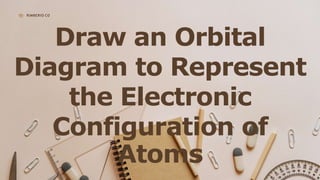Draw an Orbital Diagram...pptx
•Download as PPTX, PDF•
0 likes•158 views
Draw Orbital Diagram
Report
Share
Report
Share

Recommended
More Related Content
What's hot
What's hot (20)
Similar to Draw an Orbital Diagram...pptx
Similar to Draw an Orbital Diagram...pptx (20)
Recently uploaded
Recently uploaded (20)
Seismic Method Estimate velocity from seismic data.pptx

Seismic Method Estimate velocity from seismic data.pptx
Botany krishna series 2nd semester Only Mcq type questions

Botany krishna series 2nd semester Only Mcq type questions
Recombinant DNA technology (Immunological screening)

Recombinant DNA technology (Immunological screening)
Stunning ➥8448380779▻ Call Girls In Panchshil Enclave Delhi NCR

Stunning ➥8448380779▻ Call Girls In Panchshil Enclave Delhi NCR
All-domain Anomaly Resolution Office U.S. Department of Defense (U) Case: “Eg...

All-domain Anomaly Resolution Office U.S. Department of Defense (U) Case: “Eg...
Disentangling the origin of chemical differences using GHOST

Disentangling the origin of chemical differences using GHOST
Forensic Biology & Its biological significance.pdf

Forensic Biology & Its biological significance.pdf
Hubble Asteroid Hunter III. Physical properties of newly found asteroids

Hubble Asteroid Hunter III. Physical properties of newly found asteroids
Chemical Tests; flame test, positive and negative ions test Edexcel Internati...

Chemical Tests; flame test, positive and negative ions test Edexcel Internati...
❤Jammu Kashmir Call Girls 8617697112 Personal Whatsapp Number 💦✅.

❤Jammu Kashmir Call Girls 8617697112 Personal Whatsapp Number 💦✅.
TEST BANK For Radiologic Science for Technologists, 12th Edition by Stewart C...

TEST BANK For Radiologic Science for Technologists, 12th Edition by Stewart C...
Creating and Analyzing Definitive Screening Designs

Creating and Analyzing Definitive Screening Designs
Draw an Orbital Diagram...pptx
- 1. Draw an Orbital Diagram to Represent the Electronic Configuration of Atoms RIMBERIO CO
- 2. Before assigning the electrons of an atom into orbitals, one must become familiar with the basic concepts of electron configurations. Every element on the Periodic Table consists of atoms, which are composed of protons, neutrons, and electrons. Electrons exhibit a negative charge and are found around the nucleus of the atom in electron orbitals, defined as the volume of space in which the electron can be found within 95% probability. The four different types of orbitals (s,p,d, and f) have different shapes, and one orbital can hold a maximum of two electrons. The p, d, and f orbitals have different sublevels, thus can hold more electrons. INTRODUCTION
- 4. Rules for Assigning Electron Orbitals Electrons fill orbitals in a way to minimize the energy of the atom. Therefore, the electrons in an atom fill the principal energy levels in order of increasing energy (the electrons are getting farther from the nucleus). The order of levels filled looks like this: 1s, 2s, 2p, 3s, 3p, 4s, 3d, 4p, 5s, 4d, 5p, 6s, 4f, 5d, 6p, 7s, 5f, 6d, and 7p Occupation of Orbitals
- 5. One way to remember this pattern.
- 6. Pauli Exclusion Principle The Pauli exclusion principle states that no two electrons can have the same four quantum numbers. The first three (n, l, and ml) may be the same, but the fourth quantum number must be different. A single orbital can hold a maximum of two electrons, which must have opposing spins; otherwise they would have the same four quantum numbers, which is forbidden.
- 7. Example 1: Hydrogen and Helium The first three quantum numbers of an electron are n=1, l=0, ml=0. Only two electrons can correspond to these, which would be either ms = -1/2 or ms = +1/2. As we already know from our studies of quantum numbers and electron orbitals, we can conclude that these four quantum numbers refer to the 1s subshell. If only one of the ms values are given then we would have 1s1 (denoting hydrogen) if both are given we would have 1s2 (denoting helium). Visually, this is be represented as:
- 8. Hund's Rule When assigning electrons in orbitals, each electron will first fill all the orbitals with similar energy (also referred to as degenerate) before pairing with another electron in a half-filled orbital. Atoms at ground states tend to have as many unpaired electrons as possible.
- 9. Example 2: Oxygen and Nitrogen If we look at the correct electron configuration of the Nitrogen (Z = 7) atom, a very important element in the biology of plants: 1s2 2s2 2p3
- 10. We can clearly see that p orbitals are half-filled as there are three electrons and three p orbitals. This is because Hund's Rule states that the three electrons in the 2p subshell will fill all the empty orbitals first before filling orbitals with electrons in them.
- 11. The Aufbau Process Aufbau comes from the German word "aufbauen" meaning "to build." When writing electron configurations, orbitals are built up from atom to atom. When writing the electron configuration for an atom, orbitals are filled in order of increasing atomic number.
- 13. Example 3:
- 14. Example 3: Orbital Diagram
- 15. Example The electron configuration for sulfur is 1s2 2s2 2p6 3s2 3p4 and can be represented using the orbital diagram below.
- 16. THANK YOU!!!